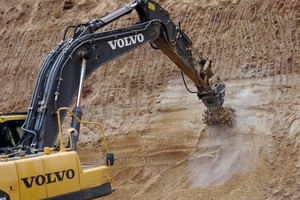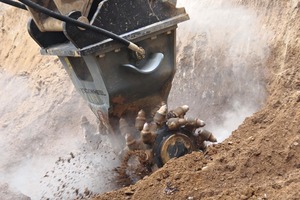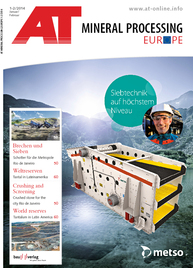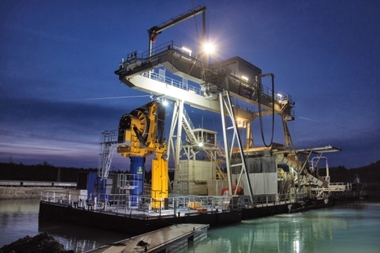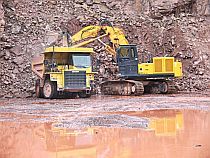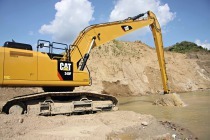Extraction rate tripled
By using the D30 Rockwheel cutting unit attached to a 36-t excavator the Saarland-based company Kies-Hector “natural concrete” recently could improve the output of sand and gravel two- to threefold. The sand and gravel conglomerate dating from the Middle Buntsandstein (Lower Triassic) is crushed at the open pit operated by August Hector KG at Saarlouis-Lisdorf. The deposit formed 150 to 240 mill. years ago at the edge of the Paris Basin has a thickness of 60 m. Under this lie carboniferous layers. The material is extracted between 230 and 180 m above sea level. The Rockwheel cutter can be used without any problems in the sandy water at the bottom of the pit.
For many years the highly abrasive conglomerate of rock class 7 in the open pit was broken away with a ripper tooth attachment (Fig. 1). “The wear was enormous. In addition the extreme impact really hits the mechanics of the excavator and the operator really hard,” says Dipl.-Ing. Andreas Fink, Technical Operations Manager, explaining why Kies-Hector started looking for an alternative method of extraction. Then he found out about the innovative cutting technology with cutting units and opted for the new extremely short Rockwheel cutting technology from Rokla GmbH, a company based in Baden-Württemberg/Germany, with its three main components: housing, motor and cutting heads equipped with picks that led the field. In November 2013 a gearless Rockwheel D30 was delivered to Kies Hector. This 1200-mm-wide, extremely rugged cutting unit with direct drive has 110 kW input power. The two rock drums are fitted with 60 wear-protected special picks for use in the highly abrasive sand-gravel conglomerate (Fig. 2). These picks have a small “head” and more “body” than the leaner traditional picks.
According to Andreas Fink, the bolts attaching the excavator boom are exposed to a lower mechanical load during extraction at the workface of the pit. And therefore for Michel Weisse, the excavator operator, the vibrations of the cutter are physically much less strenuous and tiring than the enormous jolts experienced when the ripper tooth is used. Another advantage of this cutting technology is the extraction rate. With the Rockwheel D30 and the special picks for abrasive rock at the Hector site at Lisdorf, 15 t material per hour are extracted. With a ripper tooth attached to the same 36-t-Volvo excavator, the extraction rate in the conglomerate layer, which has an extremely high quartz content (silica) of 95 %, was just 4 t/h.
The material extracted at the Erika site is also processed in Lisdorf. The company supplies fine gravel 0/4 mm as well as coarse aggregates: gravel and chippings 4/8, 8/16 and 16/32 mm. The Rockwheel D30 attached to the 36-t excavator with Verachtert-CW45S quick coupler is the most powerful of the four direct-drive Rockwheel cutters D10 (29 kW for excavators between 7 and 15 t unit weight), D15 (44 kW, 12-18 t), D20 (70 kW, 16-26 t) and D30 (110 kW, 26-38 t).

